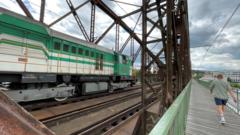The iconic Vysehrad railway bridge, a towering emblem of Prague's architectural heritage for over a century, has found itself at the center of a contentious debate. As the Czech capital, loved for its rich history and stunning vistas, plans to replace the 123-year-old structure, many voices are rising in opposition.
Architect and bridge engineer Petr Tej passionately defends the bridge, linking its significance to the city's skyline alongside the majestic Vysehrad fortress. "The panorama it forms is equally vital as that of the Charles Bridge and the Prague Castle," he stated while inspecting the bridge’s rust-laden girders.
Despite ongoing train operations, Tej and fellow philanthropist Tomas Bistricky advocate for restoration rather than outright demolition. They argue that the Railway Authority has overestimated the extent of necessary repairs, claiming that only 15% of the structure requires replacement—dramatically less than the 70% indicated by prior evaluations. Their initiative to repair and retain the bridge has gained traction, even securing Unesco’s endorsement and the backing of over 25,000 residents who favor preservation.
Meanwhile, Pavel Paidar, director at the Railway Authority, insists that the aging bridge's structural weaknesses make it increasingly incapable of accommodating future rail traffic demands. He notes that while it currently supports a significant portion of the city's rail load, corrosion compromises its capacity. The proposed new bridge would not only introduce an additional track but also enhance the wider transportation network, ensuring improved connectivity across the region.
Opposition remains fierce, however, particularly regarding plans to relocate the existing bridge about eight kilometers south to Modrany. Critics contend that the new location fails to honor its urban heritage, as the river there is narrower and would clash with its former context.
"This isn't about conflicting interests," argues Bistricky. "Rather, our studies reveal that both modern transport needs and heritage preservation can coexist."
As Prague grapples with this significant decision, the fate of the Vysehrad bridge raises poignant questions about the balance between progress and cultural legacy—an issue likely to demand resolution from authorities deeply invested in the city's historical identity.





















